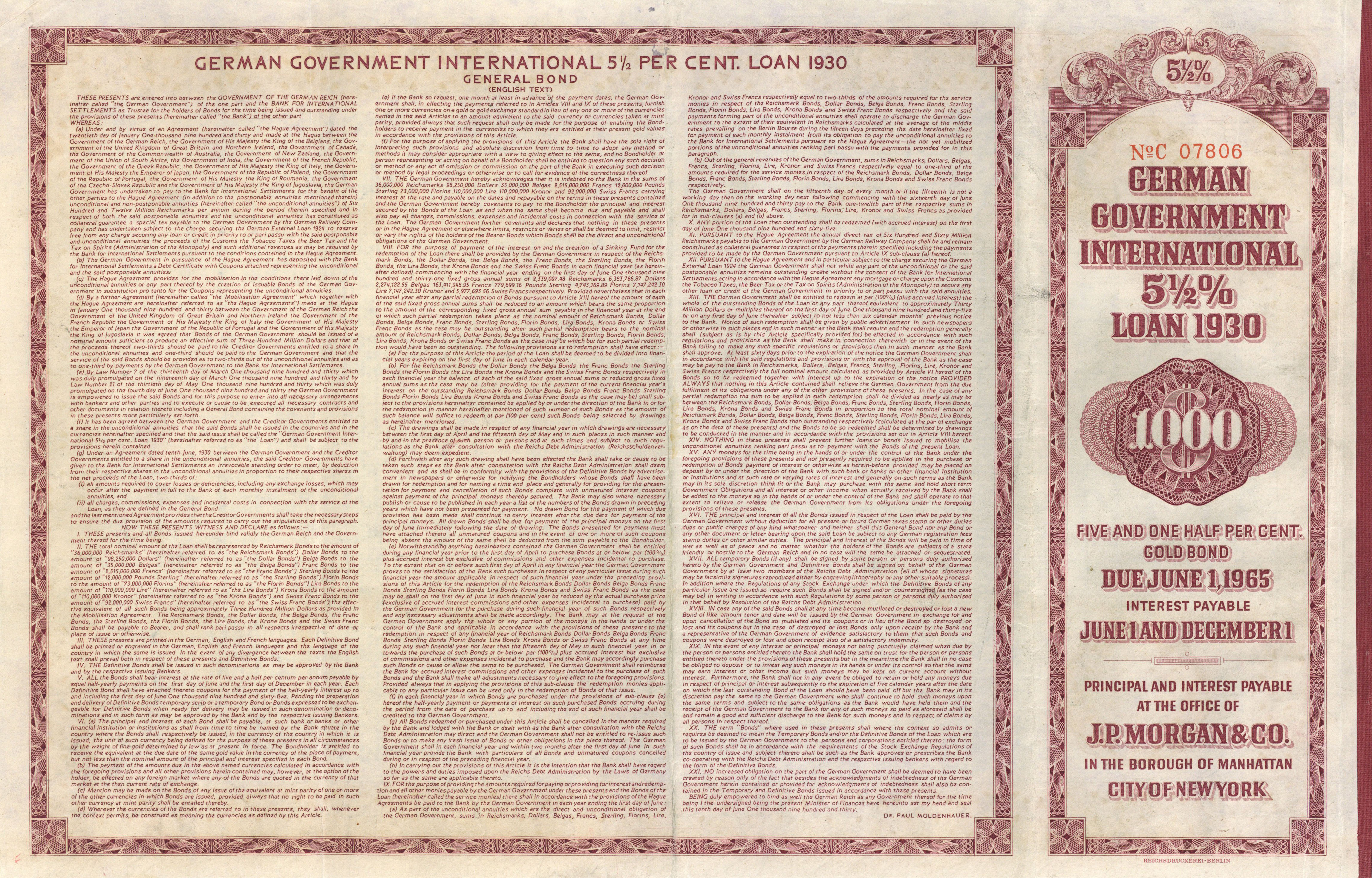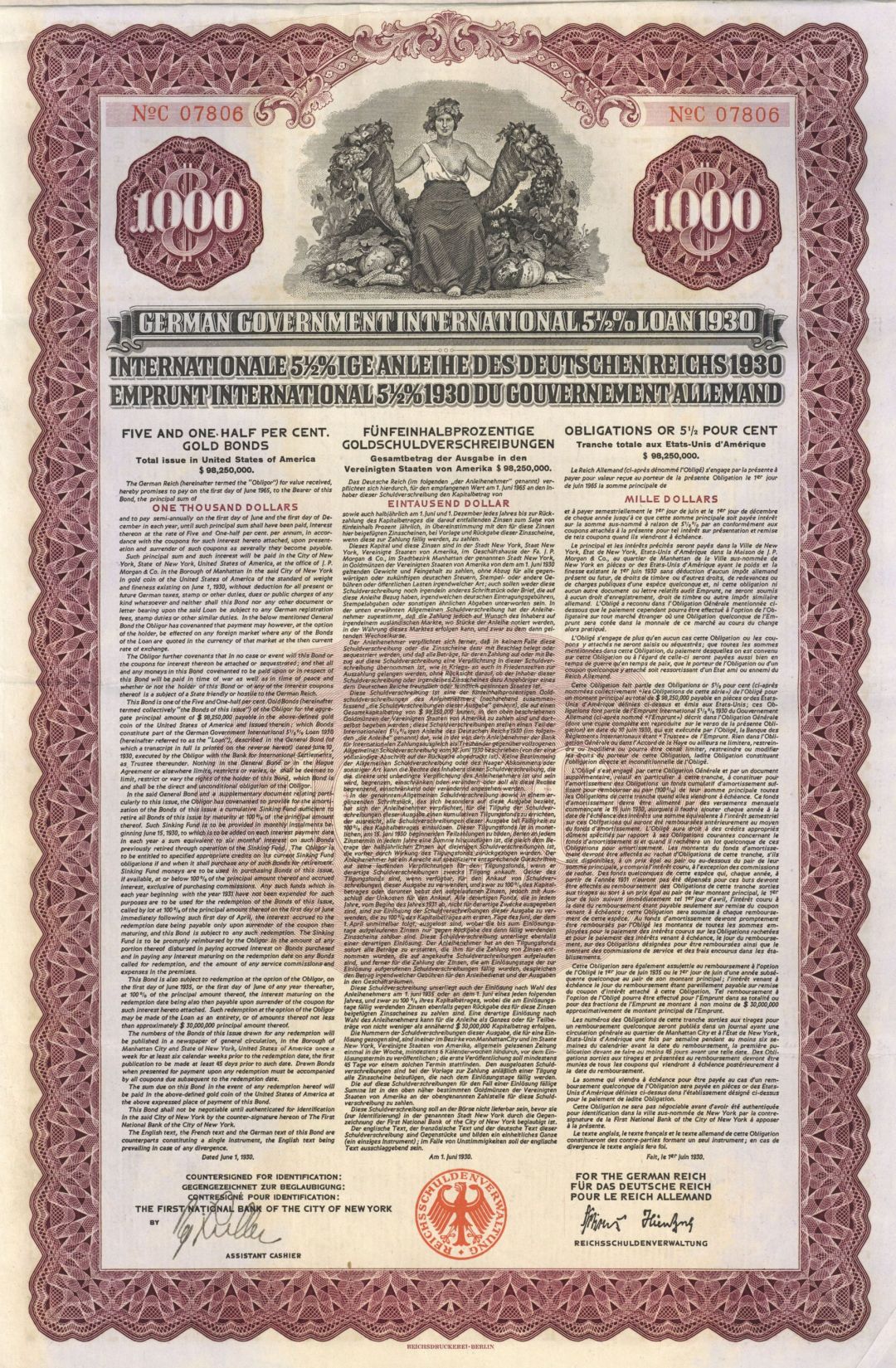German Young Gold Loan 1930 Uncancelled $1,000 Denominated Bond with Pass-co Authentication (Uncanceled)
Inv# FB6008 Bond
German Government International 5 1/2% Loan 1930 Uncanceled Bond. Traditional remaining amount of 41 coupons attached. Text in English, German, and French. INCLUDES A PASS-CO AUTHENTICATION
The Young Plan was a program for settling Germany's World War I reparations written in August 1929 & formally adopted in 1930. It was presented by the committee headed (1929–30) by American industrialist Owen D. Young, founder & former chairman of Radio Corporation of America (RCA), who, at the time, was a member of the board of trustees of the Rockefeller Foundation, Young also had been one of the representatives involved in a previous war-reparations restructuring arrangement—the Dawes Plan of 1924. The Inter-Allied Reparations Commission established the German reparation sum at a theoretical total of 132 billion, but a practical total of 50 billion gold marks. After the Dawes Plan was put into operation in 1924, it became apparent that Germany would not willingly meet the annual payments over an indefinite period of time. The Young Plan reduced further payments by about 20 percent. Although the theoretical total was 112 billion Gold Marks, equivalent to US ca. $27 billion in 1929 (US$ 121 billion in 2021) over a period of 58 years, which would end in 1988, few expected the plan to last for much more than a decade. In addition, the Young Plan divided the annual payment, set at two billion Gold Marks, US$473 million, into two components: one unconditional part, equal to one third of the sum, & a postponable part, equal to the remaining two-thirds, which would incur interest & be financed by a consortium of American investment banks coordinated by J.P. Morgan & Co.
The committee, which had been appointed by the Allied Reparations Committee, met in the first half of 1929, & submitted its first report on June 7 of that year. In addition to Young, the United States was represented by J. P. Morgan, Jr., the prominent banker, & his partner, Thomas W. Lamont. The report met w/ great objections from the United Kingdom but, after a first Conference in The Hague, a plan was finalised on August 31. The plan was formally adopted at a second Hague Conference, in January 1930.
Amongst other provisions, the plan called for an international bank of settlements to handle the reparations transfers. The resulting Bank for International Settlements was duly established at the Hague Conference in January.
Between agreement & adoption of the plan came the Wall Street Crash of October 1929, of which the main consequences were twofold. The American banking system had to recall money from Europe, & cancel the credits that made the Young Plan possible. Moreover, the downfall of imports & exports affected the rest of the world. By 1933, almost two-thirds of world trade had vanished. A new trade policy was set w/ the Smoot–Hawley Tariff Act. The latter was influenced by nationalism & the adopted economic policy. Unemployment soared to 33.7% in 1931 in Germany, & 40% in 1932. Under such circumstances, U.S. President Herbert Hoover issued a public statement that proposed a one-year moratorium on the payments. He managed to assemble support for the moratorium from 15 nations by July 1931. But the adoption of the moratorium did little to slow economic decline in Europe. Germany was gripped by a major banking crisis. A final effort was made at the Lausanne Conference of 1932. Here, representatives from Great Britain, France, Italy, Belgium, Germany & Japan gathered to come to an agreement. By that time it was clear that the deepening depression had made it impossible for Germany to resume its reparations payments. They agreed:
- Not to press Germany for immediate payments.
- To reduce indebtedness by nearly 90% & require Germany to prepare for the issuance of bonds. This provision was close to cancellation, reducing the German obligation from the original $32.3 billion to $713 million.
- It was also informally agreed among the delegates that these provisions would be ineffective unless the US government agreed to the cancellation of war debts owed by the Allied governments.
Hoover made the obligatory public statement about the lack of any connection between reparations & war debts, however in December 1932, the U.S. Congress rejected the Allied war debt reduction plan, which technically meant that the war reparations & debt reverted to the debt reduction previously granted Germany by the 1929 Young Plan. However, the system had collapsed, & Germany did not resume payments. Once the National Socialist government consolidated power, the debt was repudiated & Germany made no further payments. By 1933, Germany had made World War I reparations of only one eighth of the sum required under the Treaty of Versailles, & owing to the repudiated American loans the United States in effect paid "reparations" to Germany. The plan ultimately failed, not because of the U.S. Congress' refusal to go along, but because it became irrelevant upon Hitler's rise to power.
After Germany's defeat in World War II, an international conference (London Agreement on German External Debts, 1953) decided that Germany would pay the remaining debt only after the country was reunified. Nonetheless, West Germany paid off the principal by 1980; then in 1995, after reunification, the new German government announced it would resume payments of the interest. Germany was due to pay off the interest to the United States in 2010, & to other countries in 2020. In 2010, Time reported that Germany made "final reparations-related payment for the Great War on Oct. 3, nearly 92 years after the country's defeat by the Allies."
This agreement had been preceded by bitter diplomatic struggles, & its acceptance aroused nationalist passions & resentment. It also weakened, rather than helped, the advocates of a policy of international understanding.
Although the Young plan had effectively reduced Germany's obligations, it was opposed by parts of the political spectrum in Germany. Conservative groups had been most outspoken in opposition to reparations & seized on opposition to the Young Plan as an issue. A coalition was formed of various conservative groups under the leadership of Alfred Hugenberg, the head of the German National People's Party. One of the groups that joined this coalition was Adolf Hitler & the National Socialist German Workers Party.
The coalition's goal was the enactment of the Freiheitsgesetz ("Liberty Law"). This law would renounce all reparations & make it a criminal offense for any German official to cooperate in their collection. It would also renounce the German acknowledgement of "war guilt" & the occupation of German territory which were also terms of the Treaty of Versailles.
Under the terms of the German constitution, if ten percent of the eligible voters in the country signed a petition in favor of a proposed law, the Reichstag had to put the matter to a vote. If the Reichstag voted against the law, the proposal would automatically be put to a national referendum. If fifty percent of the people voted in favor of it, it would become a law.
The Liberty Law proposal was officially put forth on October 16, 1929. The National Socialists & other groups held large public rallies to collect signatures. The government opposed the Liberty Law & staged demonstrations against it. However, the coalition succeeded in collecting enough names to put the proposal before the Reichstag. The Reichstag voted the bill down by a 318-82 margin. In the subsequent popular vote on December 22, the Liberty Law referendum, voter turnout was only 14.9%, although 94.5% of the votes cast (13.8% of registered voters) were in favor of the proposed law.
While the Liberty Law was not enacted in 1929, the campaign for it was a major factor in bringing Hitler & the National Socialists into the political mainstream. Following the defeat, Hitler denounced Hugenberg & said the loss was a result of his poor leadership. Hugenberg & many other conservatives soon found themselves being eclipsed by the National Socialists. Hitler would later enact by decree most of the proposals of the Liberty Law after achieving power.
Events in 1930 Germany:
- 23 January - The Nazi Party gains its first minister as Wilhelm Frick becomes Minister of the Interior & Education in Thuringia as part of a right-wing coalition administration.
- 27 March - The government of Hermann Müller collapses.
- 30 March - A right of centre minority government takes office under Heinrich Brüning.
- 22 June - The growth of the Nazi Party continues as they become the second biggest party in the Landtag of Saxony
- 30 June - The French Army withdraws its troops from the Rhineland.
- 16 July - The government invokes Presidential Decree in order to force through its economic reforms.
- 18 July - The Social Democratic Party of Germany (SPD) force through a vote against the rule by decree resulting in the dissolution of the Reichstag & new elections.
- July - The German State Party is formed by a merger of the German Democratic Party & the Young German Order.
- 13 August - The Roman Catholic Archdiocese of Berlin is established.
- 14 September - The federal election sees the SPD remain as the biggest party but w/ the Nazis jumping into second place. Smaller gains are enjoyed by the Communist Party of Germany, the Christian-National Peasants' & Farmers' Party & the Centre Party whilst the main losers are the German National People's Party & the German People's Party.
Read more at https://en.wikipedia.org/wiki/Young_Plan
A bond is a document of title for a loan. Bonds are issued, not only by businesses, but also by national, state or city governments, or other public bodies, or sometimes by individuals. Bonds are a loan to the company or other body. They are normally repayable within a stated period of time. Bonds earn interest at a fixed rate, which must usually be paid by the undertaking regardless of its financial results. A bondholder is a creditor of the undertaking.











Ebay ID: labarre_galleries